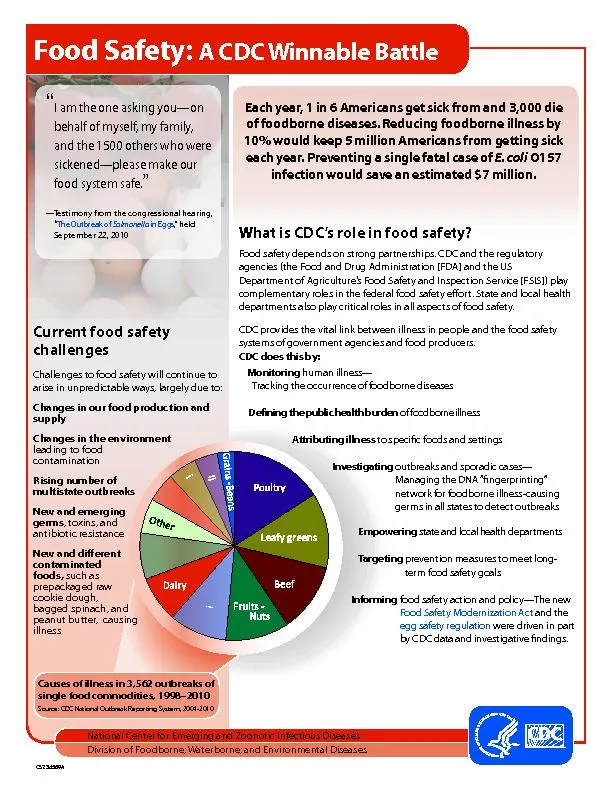/


he Outbreak of Salmonella in EggsSeptember 22 2010 Food Safety A CDC Winnable Battle What is CDC146s role in food safety Food safety depends on strong partnerships CDC and the regulatory agenci ID: 456069
Download Pdf The PPT/PDF document "I am the one asking you—on behalf o..." is the property of its rightful owner. Permission is granted to download and print the materials on this web site for personal, non-commercial use only, and to display it on your personal computer provided you do not modify the materials and that you retain all copyright notices contained in the materials. By downloading content from our website, you accept the terms of this agreement.
I am the one asking you—on behalf of myself, my family, and the 1500 others who were food system safe.—Testimony from the congressional hearing, he Outbreak of Salmonella in EggsSeptember 22, 2010 Food Safety: A CDC Winnable Battle What is CDC’s role in food safety? Food safety depends on strong partnerships. CDC and the regulatory agencies (the Food and Drug Administration [FDA] and the US Department of Agriculture’s Food Safety and Inspection Service [FSIS]) play complementary roles in the federal food safety e ort. State and local health departments also play critical roles in all aspects of food safety. CDC provides the vital link between illness in people and the food safety systems of government agencies and food producers. CDC does this by: Monitoring Tracking the occurrence of foodborne diseases De ning the public health burden of foodborne illness Attributing illness to speci c foods and settings Investigating outbreaks and sporadic casesManaging the DNA “ ngerprinting” network for foodborne illness-causing germs in all states to detect outbreaks Empowering state and local health departments Targeting prevention measures to meet long-term food safety goals Informing food safety action and policy—The new Food Safety Modernization Actegg safety regulation were driven in part by CDC data and investigative ndings. Each year, 1 in 6 Americans get sick from and 3,000 die of foodborne diseases. Reducing foodborne illness by 10% would keep 5 million Americans from getting sick each year. Preventing a single fatal case of E. coliinfection would save an estimated $7 million. Current food safety Challenges to food safety will continue to arise in unpredictable ways, largely due to: Changes in our food production and Changes in the environment leading to food contamination Rising number of multistate outbreaks New and emerging , toxins, and antibiotic resistance New and di erent contaminated foods, prepackaged raw cookie dough, peanut butter, causing Causes of illness in 3,562 outbreaks of single food commodities, 1998–2010 Source: CDC National Outbreak Reporting System, 2004-2010 National Center for Emerging and Zoonotic Infectious Diseases Division of Foodborne; Waterborne; and Environmental Diseases �� A food sleuth + shoppers’ cards = Successful investigation CDC’s disease detective Casey Barton Behravesh helped track the source of a 2010 outbreak of Salmonella infections that sickened more than 270 people in more than 40 states. What clue unlocked the mystery? Something most of us have in our wallets or on our key rings—a shopper card you swipe at the grocery store. After the Washington State Department of Health discovered that many ill people shopped at one grocery chain, they used shopper card information (with shoppers’ permission) to identify a food that the ill people had eaten: salami from one producer. A multistate investigation identi ed salami coated with pepper as the source, and it was recalled. The resourceful use of unconventional data helped CDC and its partners across the country quickly identify the source of the problem and stop the outbreak. Food sleuths continue to solve outbreaks by using shopper cards—including Salmonella contaminated Turkish Pine Nuts that sickened 43 people in 5 states in 2011. Winnable battles in food safety Decrease Salmonella and other food-related infections Accelerate the public health response to foodborne illness at the local, national, and global levels We’re taking action: Discovery—Tracking trends and risk factors, de ning the burden nding new pathogens and drug resistance, and attributing illness to speci c foods Innovation—Developing new tools, methods, and analytics in epidemiology, laboratory science, and environmental health ImplementationSharing new technology and information with local, state, and federal partners; improving communications with the public health community, industry, and consumers; and targeting information to guide policy What’s next: Centers that are faster at responding to foodborne outbreaks More e ective methods in public health laboratories to quickly identify, characterize, and ngerprint Salmonella and other food-related pathogens Improved integration of foodborne illness surveillance systems and expanded data sharing as called for in the new food safety bill Germs (and some foods) responsible for most foodborne illnesses: Campylobacter (poultry) E. coli (ground beef, leafy greens, raw milk) Listeria (deli meats, unpasteurized soft cheeses, produce) Salmonella (eggs, poultry, meat, produce) Vibrio (raw oysters) Norovirus in many foods (sandwiches, salads) Toxoplasma (meats) August 2012 Please visit us at www.cdc.gov/foodsafety Multistate foodborne outbreaks, 1020304050607080901991-19951996-20002001-20052006-2010Number of OutbreaksYearSource: CDC National Outbreak Reporting System, 2004–2010